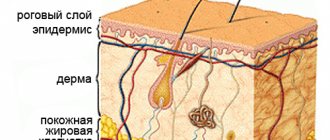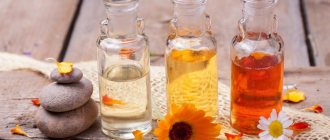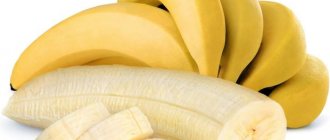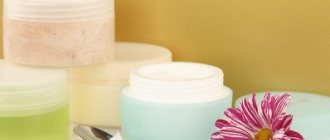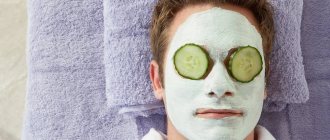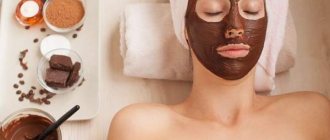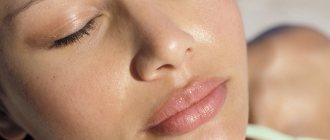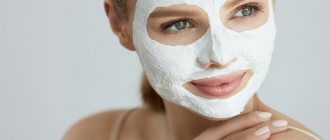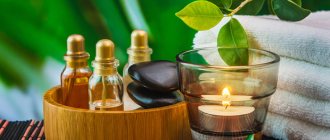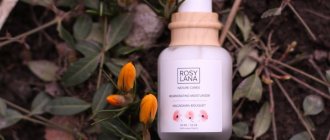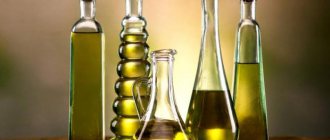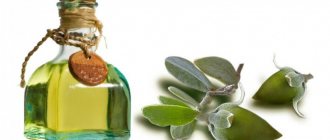Oils are one of the most popular components of cosmetics, regardless of whether it is homemade or industrial. Their demand is explained very simply. Oils are rich in fatty acids and vitamins, which are so necessary to maintain youthful and beautiful skin. However, they also have a downside, less pleasant side. Many oils can provoke the appearance of comedones (white and blackheads).
In 1984, James Fulton (dermatologist, cosmetologist, plastic surgeon) conducted a study of a number of components widely used by the cosmetic industry (including oils) for comedogenicity. As a result, each substance received a rating from 0 to 5 points:
0 - does not clog pores,
1 - low comedogenicity,
2 - moderately low,
3 - moderate,
4 - quite high,
5 - high.
Over time, the research work begun by Fulton has been continued by other scientists, and the level of comedogenicity of most oils is now known. You can use this knowledge to your advantage by assessing the composition of products before purchasing them or by making cosmetics yourself that will suit your skin type.
When studying research data, do not forget that each of us is absolutely unique. It is quite possible that oils with a comedogenicity level of 0-1 will worsen your skin, and those with a level of 3 or even 5 will suit you perfectly. This fact should always be taken into account and focus primarily on your own experience, and not on someone else’s.
What is comedogenicity
This term comes from the word “comedone”. This is the name given to blackheads that spoil the complexion and appearance of the skin, and in advanced cases lead to the appearance of acne. They appear in both adolescents and adults – age does not matter here. To understand how blackheads arise, you need to get acquainted with the structure of the hair follicle.
Follicle is a depression on the surface of the epidermis within which hairs develop. In the lumen of the cavity, the sebaceous glands produce sebum, which lubricates the hair. When this duct becomes blocked, comedones form. If a favorable environment is created, they become inflamed and acne appears.
In adolescence, this is facilitated by increased production of sebum due to hormonal changes. In adults, in addition to disorders in the body, the problem is caused by incorrectly selected cosmetics, including vegetable oils.
Vitamins A and E can aggravate the condition of oily skin.
But not all oils are equally dangerous. The fact is that some of them are highly comedogenic, while others can be used to treat oily, inflamed skin.
Oils are 95% fatty acids, the presence of which explains why pores become clogged and sebaceous plugs form. Fatty acids are divided into three types - saturated, monounsaturated, polyunsaturated.
- Saturated fatty acids are thickeners, including in relation to sebum. But such substances are useful for dry, dehydrated skin, as they soften and prevent moisture evaporation.
- Oils with monounsaturated fatty acids are light, do not leave shine and penetrate into the deep layers of the skin, transporting beneficial substances there. It is believed that such products not only do not clog pores, but even dissolve sebaceous plugs, making the face cleaner.
- If polyunsaturated fatty acids predominate in the product, then they also penetrate well deep into the dermis, helping to maintain the fat barrier. But the disadvantage of these products is that they oxidize quickly and pose certain risks for oily skin.
Cosmetologists agreed that comedogenicity would be assessed using a five-point system. The table of comedogenicity of oils in Russian will tell you what score was assigned to a particular product.
These figures may fluctuate as they are affected by the degree of purification of the product. Thus, as a result of refining, the risk is reduced.
How to choose oil according to skin type
Below you will find a universal list for each type. Trying to use them in your care, over time you will find those that suit you perfectly.
Essential.
- For dry: geranium, lavender, orange, tea tree, rosewood, neroli.
- For oily skin: rosemary, lemon, mint, ginger, lavender, patchouli, ylang-ylang, tea tree.
- For normal: lavender, lemon, geranium, rosemary, mint, jasmine, rose, neroli, ylang-ylang.
- For combination: mint, geranium, lemon, rosemary, jasmine, tea tree, bergamot, orange, lavender.
Fat.
For fatty oils (active and base) in cosmetology there is such an indicator as comedogenicity. This is how much it can clog pores and cause acne.
Also, if there is a tendency to swelling, it will aggravate it.
Comedogenicity depends on its composition, for some it is very low, and for others it is increased.
Non-comedogenic facial oils
These are oils that are assigned 0&minus.1 points on the scale mentioned above. They are liquid, flowing, light and suitable for any skin type, including oily and problem skin. The following are non-comedogenic facial oils, the list also contains a score.
| View | Points |
| Shi | 0 |
| Safflower | 0 |
| Sunflower (refined/unrefined) | 0/1 |
| Mango | 0 |
| Hemp | 0 |
| Argan | 0 |
| Rosehip | 1 |
| Black cumin | 1 |
| Sea buckthorn | 1 |
| Neem (margosa) | 1 |
| Refined sesame | 1 |
| Castor | 1 |
| Pomegranate seeds | 1 |
What types of fatty acids are the best?
Vegetable and seed oils contain two types of fatty acids - linoleic acid and oleic acid.
Alpha-linoleic acid (omega-3) and linoleic acid (omega-6) are considered “essential fatty acids” because the body cannot produce them on its own. Oleic acid is produced by the body, so it is not considered “essential”.
Knowing the difference between fatty acids and how they interact with the skin will help you choose the most effective product based on your skin type.
Moderate and low comedogenicity of oils: table
These oils manifest themselves in different ways, and their effect on oily skin is unpredictable. You can find out the effect only by trying the product. On the scale they are assigned 2&minus.3 points.
| Type of oil | Point |
| Pumpkin | 2 |
| Tamanu | 2 |
| Sandalwood | 2 |
| Peach pit (peach) | 2 |
| Almond | 2 |
| Hazelnut (hazelnut) | 2 |
| Avocado pits | 2 |
| Camphornoye | 2 |
| Jojoba (liquid wax from nuts) | 2 |
| Grape seeds | 2 |
| Baobab seeds | 2 |
| Peanut | 2 |
| Apricot kernel | 2 |
| Cotton | 3 |
| Soy | 3 |
| Olive | 3 |
| Macadami | 3 |
| Unrefined sesame | 3 |
| Corn | 3 |
Oils with linoleic acid
Research has shown that people with acne have low levels of linoleic acid in lipids on the skin's surface. Adding oils rich in fatty acids is the best way to solve this problem.
Linoleic acid is an essential omega-6 fatty acid that is not produced by the body. It has anti-aging, barrier, protective, soothing and balancing properties and is most suitable for oily and acne-prone skin.
The highest ratios of linoleic acid are found in black cumin, evening primrose, hemp, grape, guava seed, passion fruit, red raspberry, rose hip, safflower, sunflower, soybean and wheat germ oil. Borage, castor, cherry, chia, kiwi, pomegranate and sesame oils contain high amounts of linoleic acid, but have a more balanced profile.
The highest ratios of oleic acid are found in almond, apricot, avocado, carrot, hazelnut, macadamia, macula, olive and palm seeds.
Brief table
Other substances
When buying ready-made cosmetics or planning to prepare a cream at home, you should keep in mind that in addition to vegetable oils, other fats are also used.
They, in turn, can also worsen the condition of the skin, especially if it is oily and has acne.
| Drug name | Point |
| Petrolatum | 0 |
| Ceresin wax | 0 |
| Mineral | 0 |
| Candelilla wax | 1 |
| Carnauba wax | 1 |
| Beeswax | 2 |
| Emulsion wax | 2 |
| Shark liver oil | 3 |
| Lanolin | 3 |
| Mink oil | 3 |
Studies have shown that blackheads on the face also appear from the following components:
- isopryl palmiate,
- isopryl isostearate,
- sodium lauryl sulfate,
- hexadecyl alcohol,
- isostearyl neopentanoate,
- isopropyl myristate,
- isocetyl stearate,
- butyl stearate,
- Decyloleate.
Fatty acids: main components in oils
Fatty acids such as omega-3 and omega-6 are key to healthy skin. This applies not only to foods rich in these fatty acids, but also to foods containing them. In fact, research has shown that symptoms of essential fatty acid deficiency can be reversed by eating foods rich in linoleic acid.
Supplementing with linoleic acids may actually be more effective than consuming fatty acids when it comes to skin health. Many fatty acids that enter the body tend to be oxidized in the liver before reaching the skin.
Regardless of your skin type, essential fatty acids are important for health, even if you are not deficient in them.
It is well known that overexposure to ultraviolet radiation can cause skin cell damage, including inflammation, as well as suppression of the immune system in the skin itself. Premature aging results from the breakdown of collagen in skin cells and causes loss of elasticity, leading to wrinkles. Fatty acids in foods help protect and may even help eliminate these harmful effects.
What benefits oily skin?
The following oils stabilize the condition of oily skin, eliminate inflammation and improve complexion:
- from hazelnut kernels &mdash, reduces pore size, smoothes, regenerates,
- grape seeds &mdash, moisturizes, makes pores less noticeable,
- jojoba &mdash, protects from ultraviolet radiation, retains moisture, nourishes,
- apricot kernels &mdash, restores elasticity, softens, moisturizes,
- baobab &mdash, relieves acne, preserves turgor and youth,
- almond &mdash, cleanses pores, brightens redness.
Remember: it is impossible to replace skin care with oils alone, especially in adulthood.
And finally. The human body has its own characteristics. Therefore, we can only talk about comedogenicity as a trend. People may react differently to the same substance. Therefore, you should try the products carefully, even if the manufacturer promises that shea butter is of a low level of comedogenicity, especially if the quality of the product is low.
In addition, most products were tested on rabbit ears, and cosmetics do not always behave the same way on human skin. The problem also arises with an excess of fatty acids.
Some fats are necessary for the skin and can improve its condition even in advanced cases, since these substances are not synthesized by the body on its own. Therefore, it is a mistake to think that for oily skin, fat-free cosmetics are recommended; the composition should contain oils, but in the correct ratio. For oily and combination skin types, it is recommended to avoid using pure oils.
I won the battle! Care for oily and problematic skin. Chapter 5 “Essential and base oils”
Good day to all! Well, my dear owners of oily and problem skin, and other girls interested in this issue! A whole year has passed since I announced myself and my acne problem here on Cosmetist. During this time, we learned how to properly wash and tone, learned how to choose the right cream, and also became acquainted with the basics of deep cleansing the skin at home through masks and peelings. It's time to approach the most sensitive topic - the topic of caring for oily and problematic skin using essential and base oils. I present to your attention my somewhat contradictory and confusing, but ultimately successful oil experience.
By tradition, I would like to start, first of all, with theory. The theory behind essential and carrier oils is complex and complex. You can write a whole book about this and even defend a dissertation. I will try to keep it to the bare minimum and present here only those basics that will be useful to us when working with the phenomenon of oily and problem skin. So, as you probably already understood from the first parts of my story, owners of oily and problematic skin face two main tasks: firstly, constant exfoliation, and secondly, the fight against bacteria. What can essential and base oils give us in this situation? Essential or base oil in its most general form is a product given to us by nature itself, obtained by some kind of cold or hot pressing, by extraction, pressing or some other way (to combat the problem of acne, this is not so important , so I won’t bother you with chemistry lessons). And if the method of obtaining oils is not so important and necessary for us, then let’s look at the composition of essential and base oils in a little more detail. This is important for understanding how and why oils work on our skin. In particular, base oils are based on saturated and unsaturated fatty acids, which themselves actively participate in the metabolic processes occurring in the human body, including the regulation of hormonal processes. Probably everyone knows that consuming flaxseed oil stimulates the active production of estrogen-type hormones (female hormones). Accordingly, the use of base oils through external use can also lead us to certain results. The composition of essential oils is more complex. In particular, almost any essential oil consists of monoterpenes, esters, phenols, aldehydes, ketones and sesquiterpenes. All of this that I have listed has strong anti-inflammatory, antiseptic, wound-healing, antifungal, antiviral, immunostimulating and bactericidal properties. Essential oils are excellent bacteria killers, including activity against propioni bacterium acne. And this, you see, is exactly what we need! Among other things, we can find vitamins, minerals, as well as other useful micro- and macroelements in essential and base oils. Thus, essential and base oils will never, under any circumstances, be perceived as hostile by our own body, since our body itself actively uses all the substances that are included in their composition. But here it is necessary to remember the precautions and observe safety precautions. Any oil, be it essential or basic, when used correctly, will give an unconditional positive effect, saturate the skin with vitamins, moisturize it, nourish and soothe it. However, if we overdo it with base oil, we will end up with clogged sebaceous glands, and if we overdo it with essential oil, we will see an allergy or burn on our face. Therefore, the question of measure in this case is extremely important. You must understand what you are dealing with. Any medicine can become a deadly poison for a person if the proportions are not observed. The same thing needs to be remembered when working with oils, whether carrier or essential. Through trial and error, over and over again clogging my sebaceous glands, burning my skin, but without losing hope and faith in the best, I managed to select for myself wonderful complexes of essential and base oils, which not only completely relieved me of the disease, but also brought all other indicators of my skin into complete order. So, let's look at my helpers (or vice versa enemies) in more detail:
1. Kosmoteros Professionnel Complexe de Vitamines (Kosmoteros Vitamin Complex)
The vitamin complex from Kosmoteros became my first oil-type product. At first, in the fight against my illness, I simplified my care to a minimum. Essentially, it came down to proper washing, medications and daily clay masks. No tonics, lotions, serums, creams, and especially oils. Then I perceived all such remedies with hostility, since it was improper care that aggravated my problem. The condition of my face was slowly but surely made worse by skin care systems from Yves Rocher and then from Mary Kay. I honestly don’t want to criticize these systems, but, in my opinion, at best, they don’t work at all; at worst, these tools become real pests. At least in my case, over four years of using skincare products from Yves Rocher and Mary Kay, this is exactly what happened. However, gradually, step by step, I had to study the issue of moisturizing and nourishing the skin, since treating the skin with retinoids and acids inevitably entails dryness and irritation. In order to improve the situation with the texture and relief of the skin, the cosmetologist advised me to purchase Kosmoteros Professionnel Complexe de Vitamines (at that time we had already moved from the stage of fighting inflammation to the stage of fighting post-acne). This complex contains sweet almond oil, grape seed oil, sea buckthorn, jojoba, wheat germ, vitamins A, E, F, C, B5, as well as lemon essential oil. Using Kosmoteros Professionnel Complexe de Vitamines showed me results from the first use. I always applied the product and always apply it at night. Oil is oil. Nobody wants to shine like a greasy pancake all day long, so we only work with him on the night shift. The next morning the skin is fresh, rested and toned. The complexion gradually evens out, post-acne spots slowly but surely disappear. Oil (one hundred percent tested on itself) increases tone, restores the epidermis, nourishes, softens, protects, regenerates and renews the skin, slightly eliminates inflammation, prevents roughness, dryness, peeling, rashes, whitens the skin, reduces pigmentation, moisturizes, soothes, relieves irritation and itching, improves skin color. And all this in one bottle! The oil smells pleasantly of lemon and is yellow in color. The texture is liquid, light and weightless. Here are actually a few photos:
The oil does not clog the sebaceous glands at all. You can use it safely and confidently. Among other things, the oil is very economical. For any purpose of use, just 1-3 drops of this wonderful product are enough. The vitamin complex has become my faithful companion and assistant. One bottle lasts me almost a year. I have been using the oil continuously for three years. After washing, toning and moisturizing, I drip 1-2 drops of oil into the palms of my hands, thoroughly rubbing them between them, and gently patting the product over the skin of the face. Or I simply skip the step of applying the cream and use this product in mono mode. All this is not only useful, but also incredibly pleasant; during the procedure you feel like in a real beauty salon. Price: about 1,000 rubles (I think that for such an economical product, taking into account all its advantages, this is nothing at all) Rating: 5+ Duration of use: 3 years (daily on top of cream or immediately on clean facial skin before bed) .2. Clarins Huile Lotus Face Treatment Oil (Clarins Facial Oil for combination or oily skin Lotus).
I purchased Clarins Huile Lotus Face Treatment Oil under the influence of various bloggers, Beauticians, as well as other sites of this type. Many people praise him very much. I spent half my salary on it and came home satisfied and happy. She opened the precious box, examined it from all sides, listened to the aroma of the oil and, having washed herself thoroughly, applied the product to her face. I did this for about a week, without mixing the oil with any products, in order to understand what it was like as such. The main components of Clarins Huile Lotus Face Treatment Oil are rosemary and geranium essential oils, lotus extract and nut oil. The composition seems to be good and by all indicators the oil should work. But it didn't work for me. How disappointed I was after two weeks of use! The sebaceous glands were clogged one after another, closed comedones appeared like mushrooms. As a result, the inflammatory process began. I am attaching a photo, it is not of very good quality, it was taken with the front camera, but, nevertheless, in the photo, in any case, several inflammatory elements are visible.
I haven’t seen anything like this on my face at that time for a long time. If inflammation did appear, it was rare, once a month, and there was only one (inflammation), but here there were 5-7 pimples at once plus clogged sebaceous glands. Clarins Huile Lotus Face Treatment Oil is not even close to Kosmoteros Professionnel Complexe de Vitamines. Oil from Clarens is inferior to oil from Kosmoteros in its properties, the number of active ingredients, as well as its unjustifiably high price. Clarins Huile Lotus Face Treatment Oil has been in the refrigerator for about a year, and after writing my review about it, I throw it in the trash with a calm heart. It's a pity! But what can you do... Price: about 4,000 rubles Rating: 2 Duration of use: 14 days (daily immediately on clean facial skin before bedtime).
3. Spivak Shea Butter (unrefined)
Shea (Shea) butter is my absolute favorite in the world of oils. Everything about it is wonderful - properties, texture and aroma. The subtle nutty, delicate and natural aroma drives me crazy. I use this oil everywhere and always. I use it as a body cream, a face cream, apply it to my lips, restore the thin and delicate skin of my eyelids, apply it in its pure form to the entire length and roots of my hair at night, and take care of my hands and nails. In general, if someone ever sees me in the evening, they will see me, with a hundred percent probability, shiny and oily. And this oil on me will be Shea butter. Let us turn to the composition and main properties of Shea butter (Karite). Shea butter mainly consists of fatty acids, which are: oleic (40 to 55%), stearic (35 to 45%), palmitic (3 to 7%), linoleic (3 to 8%) and linolenic acid (1%). In this connection, Shea butter has high protective, wound-healing, bactericidal and restorative properties. Shea butter copes well with rashes, perfectly soothes the skin, and somehow simply magically cleanses the sebaceous glands. I use the oil exclusively at night. After the washing procedure, I warm up and rub a piece of oil in my palms with quick movements and apply with soft patting movements to the face, including the delicate skin around the eyes and lips. So I go to bed. I don’t always use Shea butter, but depending on my mood. I can apply it once a month, or I can use it for several weeks in a row. Thanks to Shea butter, I gradually improved the skin on my back, which was much more problematic than the skin on my face. Now I take care of my body only with the help of this very oil. Over the course of a year of use, I used up three full jars, which means I literally eat this butter. The third jar in the photo is almost empty, you need to buy a new one to replace it.
4. Spivak Neem Oil (unrefined)
Neem oil is extracted from the seeds of the tree of the same name, native to India. The oil is very controversial because it has an incredibly terrible smell and bitter taste. The main components of Neem oil are oleic, palmitic, stearic, linoleic, arachidonic acids, polyphenols, vitamins E, A and C. The above composition determines the antibacterial, antiseptic, antifungal, wound-healing, moisturizing, anti-inflammatory, antioxidant, regenerating and wound-healing properties of this miracle oil . Neem tree oil helps suppress the pathogenic microflora of our body, in particular, the oil is active against viruses, fungi, bacteria and microbes hostile to us. In other words, Neem tree oil is a natural antibiotic and fights such ailments as dandruff, psoriasis, lichen, acne, eczema, rosacea, etc. According to some sources, Neem tree oil is known as a natural contraceptive. Therefore, it is better for pregnant women and those wishing to become pregnant to avoid this oil in any form. The smell of this oil doesn't seem that bad to me. It smells like onions, but I love onions. Therefore, I calmly use this oil instead of night cream. I rub a small amount of oil between my palms and also gently apply it to freshly washed facial skin. The effect of the oil is amazing. It gradually evens out the complexion, cleanses pores, normalizes the functioning of the sebaceous glands, making the skin smooth, velvety and soft. The next morning you want to touch your face, touch it, the skin of your face glows from the inside. I am attaching a photo with the consistency for clarity:
Price: about 200 rubles Rating: 5 Duration of use: 6 months (several times a week instead of cream, directly on clean facial skin before bed).
5. Spivak Black Cumin Oil (unrefined)
Black Cumin (or Cumin) oil contains a huge amount of essential and valuable components, including unsaturated fatty acids, beta-carotene, calcium, iron, copper, vitamins A, E and D, amino acids, flavonoids, phytosterols and tannins. Possessing antioxidant properties, the oil increases the protective functions of the skin, protects it from free radicals, thereby preventing premature aging. Black Cumin oil also exhibits good wound healing ability, actively stimulating regeneration processes in damaged areas, and affects the production of collagen by the body. Due to the presence of phytosterols, the oil has bactericidal and immunostimulating properties. The oil copes well with acne, eczema, psoriasis and other dermatoses. I really love Cumin oil, it smells nice, very light and weightless in texture. I use it according to my mood instead of cream. One drop is enough for the entire face. The skin after using the oil is healthy and rested. She is nourished as if from the inside.
By the way, this same oil is the main component of my favorite mattifying cream from Kosmoteros, which is probably why I adore this cream. Price: about 120 rubles Rating: 5 Duration of use: 1 year (several times a week instead of cream, directly on clean facial skin before bed).
6. Spivak Lavender Essential Oil
I would like to start the analysis of essential oils as such with my favorite, the most universal and multifunctional essential oil - Lavender oil. Lavender oil is the first essential oil that I started using in facial skin care. Before this, I used essential oils exclusively for aromatherapy purposes. Currently I have about 20 essential oils in my collection. But I use only three essential oils as care, and Lavender oil is one of them. Lavender essential oil is a powerful antiseptic, bactericidal and regenerating agent, improves blood microcirculation. Among other things, the aroma of lavender normalizes the functions of the nervous system and is used for insomnia, neuroses and diseases of nervous origin. Thus, Lavender essential oil will not only help neutralize inflammation, but also calm our nerves, give stamina and patience on the difficult path of fighting acne. At the same time, the oil is quite capricious. For care purposes, just one drop is enough; if you use more, you can get a serious burn. As such, you should not expect results in improving the structure of the skin from essential oils. We need essential oils primarily for bactericidal purposes. That is, such oils will fight inflammatory elements, showing activity against the causative agent of acne - the bacterium propioni bacterium acne. That, in fact, is all that this magical oil will do. I use Lavender oil depending on my mood several times a week at night on top of my night cream. When applied, the oil tingles the skin, but if you do not overdo the dose, then this tingling is quite tolerable and tolerable. The skin turns a little red, but the redness goes away within half an hour. In general, I will say that it was essential oils that put an end to my struggle. This was the missing fifth element. Lavender oil and other oils finally got rid of my rashes, as well as the dandruff that had previously tormented me. Additionally, I use this oil when aromatherapy, add it to oil masks for hair, and to clay face masks. Price: about 300 rubles Rating: 5 Duration of use: 1 year (several times a week, depending on the mood, on top of the cream before bed).
7. Spivak Spanish Lemon Essential Oil
The most important property that Spanish Lemon essential oil has is its whitening effect. It is effective against any disturbances in the production and distribution of melanin in the skin, be it freckles, age spots, post-acne, and so on. Spanish Lemon oil gives pale and dull skin a healthier and more radiant appearance, and also normalizes oil secretion in the skin. Lemon essential oil is a natural hair and skin lightener. Thus, Spanish Lemon essential oil, along with the previously discussed Kosmoteros Professionnel Complexe de Vitamines, performs a very important task - evens out facial skin tone and fights post-acne. But at the same time, it must be remembered that citrus oils are phototoxic. Phototoxicity refers to the ability to increase skin sensitivity to ultraviolet radiation (photosensitivity). Almost all essential oils suffer from this property. But this property is especially pronounced in citrus oils, which include orange, lemon, bergamot, grapefruit, citronella, verbena, lime, tangerine, and lemongrass oils. In connection with the above, it is strictly not recommended to use any essential oils during the day. This mistake can lead, at best, to burns; at worst, to disruption of the production and distribution of melanin in the skin and, as a result, to permanent pigment spots. Thus, we should use all products aimed at combating acne exclusively at night, be it retinoids, acids or essential oils. It is also necessary to remember that the listed components (retinoids, acids and essential oils) should never, under any circumstances, be mixed with each other. This is an absolute taboo. I adore Spanish Lemon essential oil for its pleasant citrus aroma; the oil not only brightens the skin, but also lifts your mood. Personally, the oil does not irritate my skin, so I safely use it, a few drops on the palm of my hand. I also add lemon oil to oil hair masks and clay face masks. Price: about 150 rubles Rating: 5 Duration of use: 1 year (several times a week, depending on the mood, on top of the cream before bed).
8. Spivak Eucalyptus essential oil
I will tell you briefly about eucalyptus essential oil, but to the point. Surely, everyone already knows that eucalyptus essential oil helps us fight viruses, bacteria, colds and other infections. But what is remarkable about Eucalyptus oil? Eucalyptus oil is an essential oil that has the lightest texture compared to other essential oils. At the same time, it does not exhibit any phototacticity at all. Therefore, this is the only oil that I use in the morning on top of my day cream. The oil copes well with rashes, prevents the appearance of inflammatory elements, and also helps me wake up in the morning and recover from sleep. Thus, Eucalyptus essential oil is just a nice little bonus to your morning self-care routine. And here, in fact, is the entire holy trinity of my favorite essential oils, led by Eucalyptus essential oil:
Price: about 100 rubles Rating: 5 Duration of use: 1 year (several times a week, depending on the mood, on top of day cream).
To summarize the above, I will formulate several rules for the use of essential and base oils, which I came to guide through trial and error:
Firstly,
Do not introduce essential and base oils into your care without first understanding the four main “pillars” of the fight against acne: treatment, cleansing, toning, moisturizing.
The problem of acne should not be an uncontrollable element for you; learn to “turn on” and “turn off” acne on your face at your own request. And only when you are absolutely sure that you can independently regulate the amount of inflammatory elements, feel free to start experimenting. Secondly,
do not use all essential and carrier oils at the same time.
Try to start with one thing and observe the reaction of the skin of your face and body. Thirdly,
when choosing essential and base oils, pay attention to manufacturers of natural domestic cosmetics: Spivak, Olesya Mustaeva’s Workshop, Romanov’s Soap Factory, Lavrov’s Workshop, Makosh and so on.
These oil manufacturers always produce excellent quality oils. Do not buy essential and base oils in pharmacies or other dubious places. Fourthly,
pay attention, first of all, to oils intended for the care of oily and problem skin.
Basic oils include shea butter, neem oil, laurel oil, black cumin oil, grape seed oil, green coffee oil, baobab oil, hemp oil, etc. Essential oils include rosemary, tea tree, lavender, eucalyptus, lemon, lime, cajuput, cloves, etc. Fifth,
maintain proportions.
If we overdo it with base oil, we will end up with clogged sebaceous glands, and if we overdo it with essential oil, we will see allergies or burns on our face. Therefore, when working with oils, remember the golden rule: “Less is better!” Sixth,
remember that most essential oils are phototoxic (especially citrus oils).
This means that essential oils and the sun are incompatible things. Therefore, use essential oils exclusively at night. Seventh,
never, under any circumstances, replace complete facial skin care with oils.
Oils are just oils, and they contain only part of the components our face and body need. Oils do not and will never contain the additional peptides, enzymes, extracts, most vitamins, acids and other equally useful, necessary and important substances that we need. Eighth,
don't forget to be patient. Acne is a chronic disease and it must be treated chronically, that is, constantly. This basic rule in the fight against illness applies to all aspects of the strategy (treatment, washing, toning, moisturizing, nutrition).
Phew! Well, it seems that’s all I would like to tell you about caring for oily and problematic skin using essential and base oils. The topic is very controversial and complex. For many, essential and base oils have ruined their skin, but at the same time, they have saved many. Therefore, this topic is also important and needs to be disclosed. Thank you for your attention! I wish everyone healthy, clear and glowing skin! In addition, I am attaching a small collage showing the state of my skin almost four years ago (photos from 2011 to 2014). The latest photos reflect the current state of my face. The pictures were taken a few minutes ago. Many people ask the question: “Perhaps the skin has become good because the hormonal levels have stopped fluctuating in four years and leveled out?” But this is still not the case, my skin is still the result of titanic efforts and every minute attention. My sebaceous glands don't stop for a second. But the catastrophe on my face is averted, and a nuclear war is won. 1:0 in my favor!
Increase
Dry skin
Dry skin makes people feel tight, and the skin is often scaly and has flaky patches. People with dry skin have pores that are almost invisible. There are many factors that cause dry skin, from heredity and genetics to the amount of sebum produced in the skin.
If you have dry skin, you need to regularly moisturize it during your facial. You'll also need to avoid harsh cleansers, limit your time and frequency in hot showers, use a good humidifier in your home, and consider using products that contain humectants such as hyaluronic acid.
